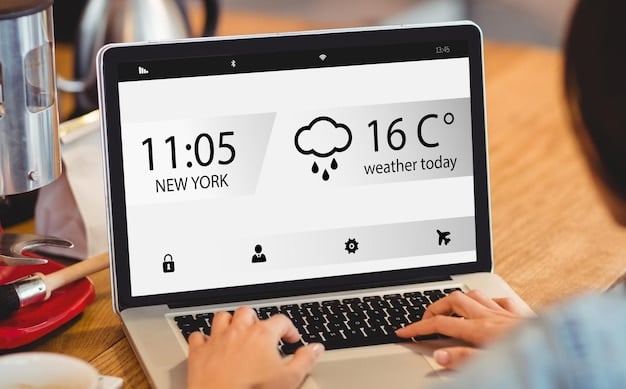US National Weather Service Alerts: Your Guide to Staying Safe

US National Weather Service (NWS) alerts provide critical information about impending hazardous weather conditions, enabling individuals and communities to take necessary precautions and ensure their safety during extreme weather events.
Navigating daily life in the US often means being prepared for a wide range of weather conditions. Understanding **US National Weather Service Alerts: How to Stay Safe During Extreme Weather Events** is crucial for every resident. These alerts provide vital, potentially life-saving information, enabling individuals and communities to take proactive steps during severe weather.
Understanding the US National Weather Service
The US National Weather Service (NWS) is an agency of the federal government responsible for providing weather, water, and climate forecasts and warnings for the United States, its territories, adjacent waters and ocean areas, for the protection of life and property and the enhancement of the national economy. It operates a network of local weather forecast offices (WFOs) across the country, each responsible for a specific geographic area.
The Mission of the NWS
The NWS’s primary mission is to protect lives and property by issuing timely and accurate forecasts and warnings. This includes monitoring weather conditions, issuing alerts, and disseminating information to the public and other stakeholders. The NWS also conducts research to improve forecast models and prediction techniques.

How the NWS Works
The NWS operates 24/7, using a variety of tools and technologies to monitor weather conditions, including satellites, radar, weather balloons, and surface observation networks. Data collected from these sources is analyzed by meteorologists at local WFOs and national centers to create forecasts and warnings. These forecasts and warnings are then disseminated to the public through various channels, including the NWS website, mobile apps, radio, and television.
The NWS also works closely with emergency management agencies and other organizations to ensure that communities are prepared for and can respond effectively to weather-related hazards.
In conclusion, the US National Weather Service plays a pivotal role in safeguarding communities against the impact of severe weather, providing essential alerts and forecasts that enable people to take necessary precautions. By understanding its mission and operations, individuals can better utilize the NWS’s resources to stay informed and safe.
Types of Weather Alerts Issued by the NWS
The NWS issues various types of weather alerts to inform the public about potential hazards. These alerts vary in severity and are designed to provide specific information about the type of weather event expected, the areas affected, and the recommended actions to take.
Watches
A watch is issued when conditions are favorable for a particular hazard to develop. It is intended to alert people that a hazard is possible and that they should monitor weather conditions and be prepared to take action. For example, a tornado watch means that conditions are favorable for tornadoes to form in the watch area.
- Tornado Watch: Tornadoes are possible in the area.
- Hurricane Watch: A hurricane poses a threat to the area within 48 hours.
- Flood Watch: Flooding is possible in the area.
Warnings
A warning is issued when a hazard is imminent or is already occurring. It is intended to prompt people to take immediate action to protect themselves and their property. For example, a tornado warning means that a tornado has been sighted or indicated by radar and poses an immediate threat to the warning area.
- Tornado Warning: A tornado has been sighted or indicated by radar.
- Hurricane Warning: A hurricane is expected to strike the area within 36 hours.
- Flash Flood Warning: A flash flood is occurring or is imminent.
Advisories
An advisory is issued for less serious conditions that may still cause inconvenience or pose a risk. Advisories often target specific hazards that are expected to occur, such as strong winds, heavy snow, or extreme heat. Unlike watches and warnings, advisories indicate conditions that are more certain to occur but are not expected to be life-threatening if precautions are taken.
Knowing the difference between watches, warnings, and advisories is essential for effective preparedness. Watches call for vigilance, warnings demand immediate action, and advisories suggest caution. By understanding these distinctions, individuals can better respond to weather alerts and protect themselves and their communities.
Accessing NWS Alerts
Staying informed about weather alerts is crucial for safety, and the NWS provides numerous ways for the public to access this information. These methods range from traditional media to modern digital platforms, ensuring that individuals can stay updated regardless of their location or technological access.
NWS Website and Mobile App
The NWS website (weather.gov) is a primary source of weather information, providing forecasts, warnings, and other products. The NWS also offers a mobile app that delivers real-time alerts and forecasts to your smartphone or tablet. These digital tools allow users to customize their location settings, receiving alerts specific to their area.

NOAA Weather Radio
NOAA Weather Radio (NWR) is a nationwide network of radio stations broadcasting weather information 24/7. NWR broadcasts warnings, watches, forecasts, and other hazard information. It is an excellent way to stay informed, especially during power outages or when internet access is limited. Many households and businesses keep a weather radio on hand for emergency situations.
Social Media and Local News
Many NWS offices use social media platforms such as Twitter and Facebook to disseminate weather information and alerts. Local television and radio stations also provide weather updates, often in coordination with the NWS. These sources can offer visual aids and expert analysis of the weather situation, complementing the information available from the NWS directly.
In summary, accessing NWS alerts is straightforward, thanks to a variety of channels tailored to different needs and preferences. Whether through the NWS website, mobile app, NOAA Weather Radio, or social media, staying informed is key to ensuring safety during severe weather events.
Preparing for Different Types of Extreme Weather
Extreme weather events can range from heat waves to blizzards, and each type requires specific preparation. Understanding the potential risks and implementing appropriate safety measures is vital for protecting yourself and your community.
Heat Waves
During a heat wave, take steps to stay cool and hydrated. Drink plenty of water, wear lightweight and loose-fitting clothing, and avoid strenuous activities during the hottest parts of the day. Seek air-conditioned environments whenever possible. Check on elderly neighbors or relatives, as they are particularly vulnerable to heat-related illnesses.
Hurricanes
If you live in a hurricane-prone area, develop an evacuation plan and assemble a disaster kit with essential supplies. Stay informed about the storm’s track and intensity, and follow instructions from local authorities. Secure your home by boarding up windows and moving outdoor furniture inside. Be prepared to evacuate if necessary.
Tornadoes
When a tornado warning is issued, seek shelter immediately in a basement, storm cellar, or interior room on the lowest level of a sturdy building. Stay away from windows and doors. If you are outdoors, lie flat in a ditch or other low-lying area and protect your head. Never try to outrun a tornado in a vehicle.
Winter Storms
Prepare your home for winter storms by insulating pipes, sealing windows and doors, and having a supply of firewood or heating fuel on hand. Keep a disaster kit in your car with blankets, extra clothing, a flashlight, and a first-aid kit. If you must travel, check road conditions and let someone know your route and estimated time of arrival.
Preparing for extreme weather involves understanding the specific risks associated with each type of event and taking proactive steps to mitigate those risks. Whether it’s staying cool during a heat wave or securing your home during a hurricane, preparedness can make a significant difference in ensuring safety.
Creating a Family Emergency Plan
Developing a family emergency plan is a crucial step in ensuring everyone’s safety during a disaster. A well-thought-out plan ensures that everyone knows what to do, where to go, and how to communicate in an emergency.
Establish Communication Protocols
Determine how family members will communicate with each other if they are separated during a disaster. Identify a central contact person who lives out of town as a point of contact. Ensure that everyone knows the contact person’s phone number and how to reach them. Text messages are often more reliable than phone calls during emergencies, so establish texting as a primary mode of communication.
Identify Meeting Places
Designate primary and secondary meeting places in case family members are separated. The primary meeting place could be a nearby neighbor’s house or a local community center. The secondary meeting place should be a location farther away in case the primary meeting place is inaccessible. Ensure that everyone knows the addresses and directions to both meeting places.
Practice Your Plan
Regularly practice your family emergency plan to ensure that everyone is familiar with the procedures and knows what to do. Conduct drills to simulate different types of emergencies, such as a fire or a tornado. Use these drills as an opportunity to refine your plan and address any gaps or weaknesses.
Creating a family emergency plan involves establishing communication protocols, identifying meeting places, and practicing your plan. By taking these steps, families can be better prepared to respond effectively to any disaster and ensure everyone’s safety.
Community Resources and Support
During and after extreme weather events, community resources and support systems play a critical role in helping individuals and families recover. Understanding and utilizing these resources can make a significant difference in ensuring safety and well-being.
Local Emergency Management Agencies
Local emergency management agencies are responsible for coordinating disaster preparedness and response efforts within their communities. These agencies provide information, resources, and assistance to residents before, during, and after a disaster. They often operate emergency shelters, distribute supplies, and coordinate volunteer efforts.
Volunteer Organizations
Volunteer organizations such as the American Red Cross and the Salvation Army provide critical support to communities affected by disasters. These organizations operate shelters, provide food and water, offer medical assistance, and distribute essential supplies. They also rely on volunteers to carry out their mission, so consider volunteering your time and skills.
Community Support Groups
Community support groups can provide emotional support and practical assistance to individuals and families affected by disasters. These groups often organize cleanup efforts, distribute supplies, and provide counseling services. They can also help individuals navigate the recovery process and access other available resources.
Accessing community resources and support is essential for weathering the challenges posed by extreme weather events. Whether through emergency management agencies, volunteer organizations, or community support groups, working together can help communities recover and rebuild after a disaster.
| Key Point | Brief Description |
|---|---|
| 🚨 Types of Alerts | Watches mean conditions are favorable; warnings mean a hazard is imminent. |
| 📱 Accessing Alerts | Use NWS website/app, NOAA Weather Radio, and social media for updates. |
| 🏠 Family Plan | Establish communication, meeting places, and practice emergency drills. |
| 🤝 Community Support | Local agencies and volunteer groups offer resources and assistance. |
Frequently Asked Questions (FAQ)
▼
A watch means conditions are favorable for a hazardous weather event, while a warning means the event is imminent or occurring. Prepare during a watch; take action during a warning.
▼
You can receive alerts via the NWS website, mobile app, NOAA Weather Radio, and social media. Ensure your devices are set to receive notifications for your location.
▼
Include communication strategies, designated meeting places, and evacuation routes. Practice the plan regularly to ensure everyone knows what to do in an emergency.
▼
Secure windows and doors, clear gutters and downspouts, and trim trees. Stock up on essential supplies and create a plan for evacuation if needed.
▼
Seek shelter in a basement, storm cellar, or interior room on the lowest level of a sturdy building. Stay away from windows and doors, and protect your head and neck.
Conclusion
Staying informed and prepared for extreme weather events is crucial for ensuring safety and well-being. By understanding the US National Weather Service alerts, developing a family emergency plan, and utilizing available community resources, individuals and families can effectively mitigate the risks associated with severe weather and protect themselves and their communities.





